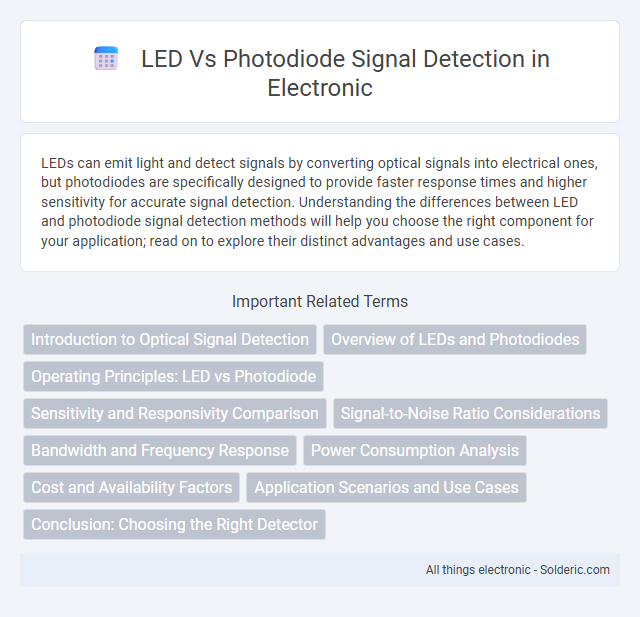LEDs can emit light and detect signals by converting optical signals into electrical ones, but photodiodes are specifically designed to provide faster response times and higher sensitivity for accurate signal detection. Understanding the differences between LED and photodiode signal detection methods will help you choose the right component for your application; read on to explore their distinct advantages and use cases.
Comparison Table
| Feature | LED (Light Emitting Diode) | Photodiode |
|---|---|---|
| Function | Emits light as an optical signal source | Detects and converts light into electrical signals |
| Sensitivity | Low, designed for light emission | High, optimized for light detection |
| Response Time | Fast light emission (nanoseconds) | Very fast electrical response (nanoseconds to microseconds) |
| Application | Signal source in optical communication | Optical signal detection in communication and sensing |
| Operational Mode | Active light emission | Passive light detection |
| Wavelength Range | Specific wavelengths depending on LED type (visible to IR) | Wide spectrum sensitivity, from UV to IR depending on material |
| Output Type | Light output (photons) | Electrical output (current or voltage) |
| Noise Level | Not applicable (emission device) | Low noise, critical for accurate detection |
| Power Consumption | Higher power for light emission | Low power, sensitive to incident light |
Introduction to Optical Signal Detection
Optical signal detection relies on converting light into electrical signals, where LEDs serve as light sources emitting specific wavelengths while photodiodes act as sensitive detectors converting incident photons into current. Photodiodes offer faster response times and higher sensitivity compared to LEDs used as detectors, making them ideal for precise measurement in communication and sensing applications. The efficiency of optical systems depends on matching LED emission spectra with photodiode spectral sensitivity to optimize signal detection performance.
Overview of LEDs and Photodiodes
LEDs (Light Emitting Diodes) function as compact, efficient light sources emitting specific wavelengths when an electrical current passes through them, making them ideal for signal transmission in optical communication. Photodiodes serve as sensitive detectors that convert incoming light into electrical signals with high speed and precision, enabling accurate signal reception and detection. Your choice between LEDs and photodiodes depends on whether you require light emission or light detection within your optical system.
Operating Principles: LED vs Photodiode
LEDs operate by converting electrical energy into visible light through electroluminescence, emitting photons when current passes through a semiconductor junction. Photodiodes function by converting light into electrical current via the photoelectric effect, generating electron-hole pairs when exposed to incoming photons. The fundamental difference lies in LEDs acting as light sources, while photodiodes serve as light detectors, each optimized for distinct roles in optical communication and sensing systems.
Sensitivity and Responsivity Comparison
Photodiodes exhibit higher sensitivity and superior responsivity compared to LEDs when used for signal detection due to their optimized semiconductor structures designed to convert light into electrical currents efficiently. The responsivity of photodiodes typically ranges from 0.4 to 0.7 A/W in the visible spectrum, significantly outperforming LEDs, whose responsivity is generally lower and less linear. In applications requiring precise light detection and minimal noise, photodiodes provide enhanced performance, making them the preferred choice over LEDs for sensitive optical signal processing.
Signal-to-Noise Ratio Considerations
LEDs typically exhibit lower signal-to-noise ratios (SNR) in signal detection due to their broader spectral output and higher noise levels compared to photodiodes. Photodiodes offer superior SNR by providing narrow spectral sensitivity and fast response times, minimizing noise interference and enhancing detection accuracy. Optimizing SNR in photodiode-based systems involves selecting appropriate filters and amplification techniques to reduce background noise and improve signal clarity.
Bandwidth and Frequency Response
LEDs typically exhibit lower bandwidth and slower frequency response compared to photodiodes, limiting their effectiveness in high-speed signal detection applications. Photodiodes offer superior frequency response due to their fast carrier recombination times, enabling detection of signals in the MHz to GHz range. This makes photodiodes more suitable for high-frequency optical communication and precise signal processing tasks.
Power Consumption Analysis
LEDs generally consume higher power than photodiodes during signal detection due to their active light emission requirements, whereas photodiodes operate with minimal power by passively detecting incoming light signals. Your choice of sensor impacts overall system efficiency, as photodiodes offer lower energy consumption, ideal for battery-operated or energy-sensitive applications. Power consumption differences influence device longevity and operational costs, making photodiodes preferable for low-power detection systems.
Cost and Availability Factors
LEDs are generally more cost-effective and widely available than photodiodes due to their mass production for lighting and display applications, making them an economical choice for signal detection. Photodiodes, while offering superior sensitivity and faster response times, tend to be more expensive and less readily available in bulk quantities. The trade-off between cost and performance influences the selection of LEDs for budget-sensitive projects and photodiodes for applications requiring high precision and speed.
Application Scenarios and Use Cases
LEDs excel in short-range optical communication and basic signal transmission due to their low cost and ease of integration in consumer electronics and remote controls. Photodiodes are preferred for high-speed data detection, precise light intensity measurement, and fiber optic communication, benefiting applications requiring high sensitivity and fast response times such as medical instrumentation and environmental sensing. Your choice depends on whether priority lies in cost-effective, broad usability or high-precision, high-speed signal detection.
Conclusion: Choosing the Right Detector
Choosing the right detector depends on your specific application requirements such as sensitivity, speed, and wavelength range. LEDs are suitable for low-cost, low-speed detection with narrow spectral bands, whereas photodiodes offer higher sensitivity, faster response times, and broader wavelength detection. Your choice will directly impact signal accuracy and system performance in optical communication or sensing setups.
LED vs photodiode signal detection Infographic

 solderic.com
solderic.com